
Eric Campbell
So far 2025 has been a discouraging year for both government and corporate action on climate change.
Governments, particularly in the West, have been cutting climate investments and rolling back policy. In the US alone, Donald Trump has put US$369 billion of clean energy investments on the chopping block while forcefully dismantling national climate regulations. The European Union, for its part, has passed omnibus legislation watering down its European Green Deal, while Germany and the United Kingdom both announced dramatic cuts to international climate finance in favour of new military spending. Meanwhile, in Canada, the federal government has dropped its world-leading consumer carbon tax, with provincial governments like British Columbia following suit, and is facing increasing pressure to repeal or re-consider other key climate policies.
Climate philanthropy, also referred to as “climate-focused philanthropy” or “climate change mitigation philanthropy”, is charitable giving that is targeted at reducing, removing and avoiding the greenhouse gas pollution that causes climate change.
The private sector, too, appears to be embracing the backslide. All of the world’s biggest banks, including Canada’s big five, have now quit the Net Zero Banking Alliance, a global coalition that once counted more than 140 financial institutions committed to shifting capital to the net zero transition. The private investment picture is murky, with global investment in climate technologies down 19 percent, while in Canada, auto manufacturers have delayed or scaled back much of the $46 billion promised since 2020 for building electric vehicles.
Suddenly, both government and private sector action on climate change, globally and here in Canada, has become much less bold and much less reliable.
The backdrop for this political and corporate recalcitrance, of course, is demonstrably worsening climate impacts. The year 2025 is expected to join 2024 and 2023 as the three hottest on record (Carbon Brief). Extreme heat, drought and wildfires are all registering record years on many parts of the planet (NOAA). And, in Canada itself, 2025 has brought historic heat waves and wildfire burn area.
It’s in this context that Clean Economy Fund has conducted its annual analysis of philanthropic giving for climate solutions in Canada. This analysis is for the year 2023, the most recent for which data is available.
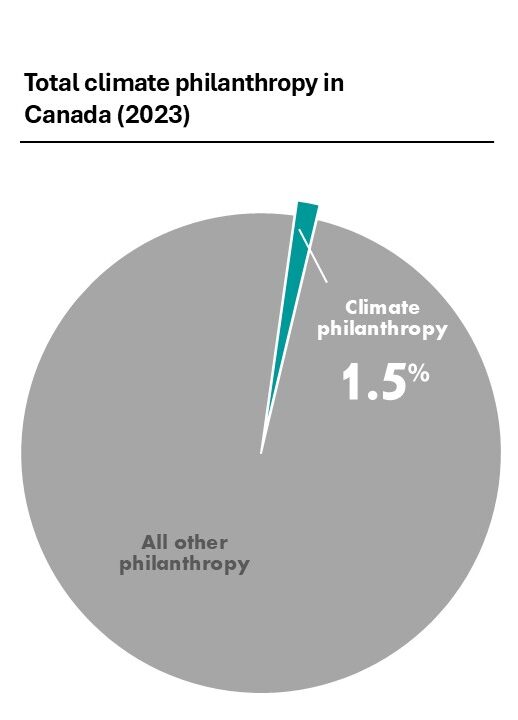
Philanthropy, after all, is a powerful force for driving Canada’s transition to a climate-safe, net-zero emissions future. Not only because, as we’ve previously shown, philanthropy is capable of unlocking much greater amounts of public and private capital – much like the first dominoes in a domino chain – but also because well-targeted philanthropy can challenge prevailing government and private sector trends, countercyclically sparking climate leadership where it would otherwise not happen.
So climate philanthropy matters – perhaps now, when government and private sector leadership is lagging – more than ever.
Yet there is a persistent shortage of climate philanthropy. According to the US-based ClimateWorks Foundation, climate philanthropy has never exceeded more than 2 percent of total philanthropic giving globally. That puts climate behind causes like animal charities and social services, and miles behind the biggest philanthropic causes like education, health and religious organizations.
The shortage of climate philanthropy persists in Canada also.
Our new analysis, for the year 2023, shows that climate philanthropy in Canada is at $389 million and comprises just 1.5 percent of total Canadian charitable giving – putting Canada below the current global average of 1.8 percent.
Climate philanthropy in Canada is at $389M and makes up just 1.5% of total charitable giving.
Contributing to Canada’s total is $131.5 million in foundation-led climate philanthropy, which includes contributions from family foundations, corporate foundations and community foundations, in addition to an estimated $257.5 million in individual and business donations.
How does Canada’s climate philanthropy compare?
At $389 million, climate philanthropy in Canada is comparatively low.
To start, Canada is behind its international peers. With 1.5 percent of philanthropic giving going towards climate solutions, Canada is underperforming against the current global average of 1.8 percent. In fact, to have met the global average, Canada would have needed to generate roughly $78 million more climate philanthropy in 2023. Unfortunately, a lack of comparable data among Canada’s international peers prevents us from making reliable country-to-country comparisons beyond the global average.
Climate philanthropy in Canada is also low compared with other charitable causes. At $389 million, climate philanthropy sits at less than half of what Canadians sent to international charities in 2023; less than one quarter of what went to health-related causes and to social services; and less than 10 percent of the philanthropy destined for religious organizations.
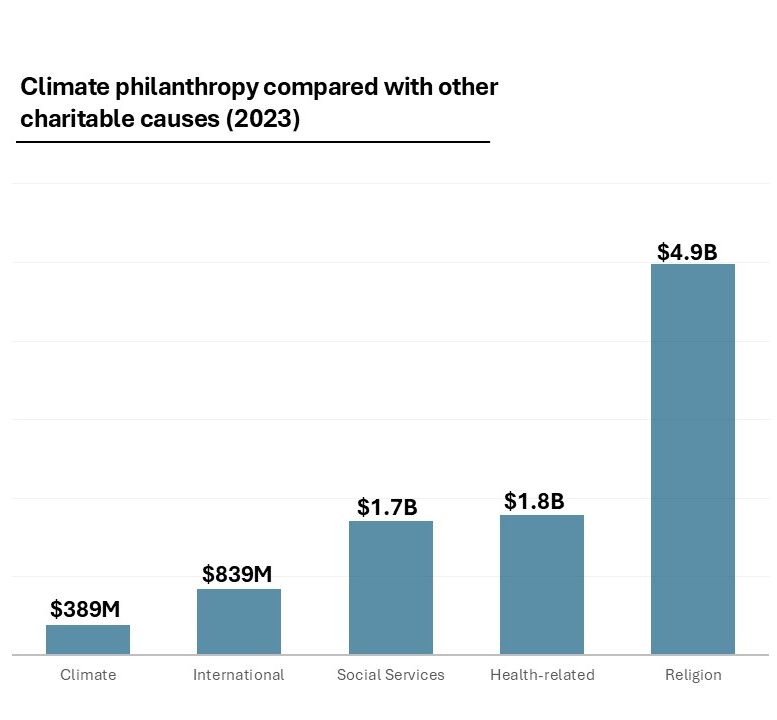
3 reasons why climate philanthropy is lagging
For many, it’s counterintuitive that climate philanthropy in Canada is so low. Afterall, almost three quarters (72 percent) of Canadians see climate change as an urgent issue. So why then is it the target for only 1.5 percent of our charitable giving? Recent insights provide us with some clues.
- Pessimism. In its 2025 Giving Report, CanadaHelps, an online giving platform, notes that Canadians who feel dejected about solving climate change are at least three times less likely to give charitably to climate solutions. Considering climate pessimism is widely prevalent, it is no doubt also affecting those in the philanthropic space and would-be donors. Increased philanthropy could come with increased confidence in our ability to solve the problem.
- Perceived Responsibility. Another clue can be drawn from the public opinion polling that shows Canadians believe the primary responsibility for solving climate change belongs to governments and businesses. Many potential donors and philanthropic leaders are likely unclear about what role philanthropy can even play in solving climate change. That suggests we need to get better at making the connections between philanthropy and impact.
- Lower Familiarity. Ultimately, we at the Clean Economy Fund put our stock in one overriding explanation for Canada’s low level of climate philanthropy: it’s simply that climate change has emerged more recently as a societal issue and, as a result, the pathways for philanthropy are less understood.
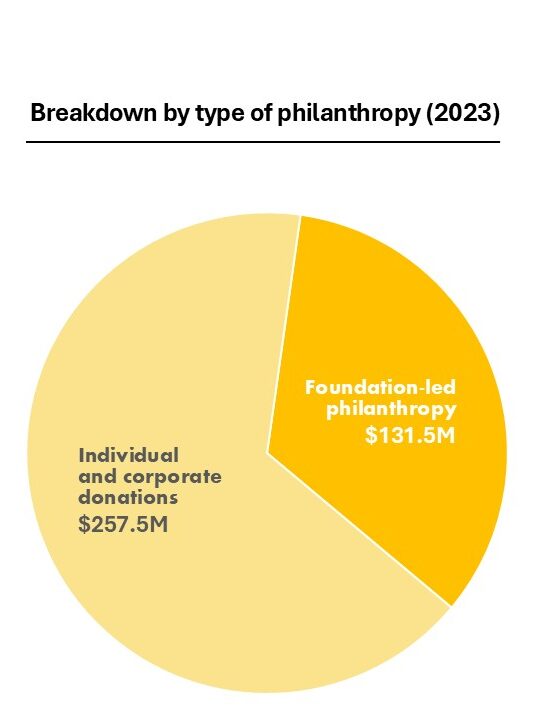
While climate change has emerged as a top issue for Canadians over the past 25 years, it’s less familiar and less entrenched than the more popular philanthropic causes in Canada. Even among environmental causes, climate change is less familiar. Grants data shows that environmental issues with longer track records, like nature conservation, are the recipients of sometimes more than twice as much philanthropy as climate solutions.
Signs of momentum.
The good news is climate philanthropy – both from foundations and from individual and business donations – showed significant signs of momentum in 2023.
When it comes to foundation-led philanthropy, which saw more than 70 private and public foundations giving a total of $131.5 million in climate-focused grants in 2023, we see two encouraging trends.
First, we see many existing climate funders increasing their commitments to climate solutions. The two examples that stand out are the Ivey Foundation, which in 2023 began spending down its entire $100-million endowment over five years, all for the sake of climate solutions, and the Trottier Family Foundation, which announced a stunning $20-million per year increase in its climate grant-making beginning as of 2023.
The second encouraging trend we see is new funders entering into the fray. Like the Peter Gilgan Foundation, which in 2023 launched a robust climate program that grew its climate-grantmaking almost tenfold. Also the Ronald S. Roadburg Foundation, based in Vancouver, which began ramping up its ambitious climate program in 2023. Finally, as of 2023, we also see a growth in Donor Advised Funds, and in particular those held at community foundations, beginning to get more engaged in climate solutions.
The latest upshot of this momentum, if we fast forward a few months and afford ourselves a sneak peak at 2024 and 2025, is major new pledges of climate funding by foundations, including $481 million over ten years committed through Clean Economy Fund’s Climate Champions platform.
At the same time as these encouraging signs from foundation-led philanthropy, there was a big lift in the charitable donations coming from individual households and businesses in 2023. According to the annual charity snapshot prepared by Blumbergs, charitable organizations across the board in Canada reported a 12 percent increase in revenue from individual, corporate and otherwise tax receipt-able donations in 2023. While the data doesn’t allow us to see exactly which causes those individual and corporate donations went towards, this boost inevitably provided a positive shot in the arm for the important climate work being advanced by Canada’s charitable sector
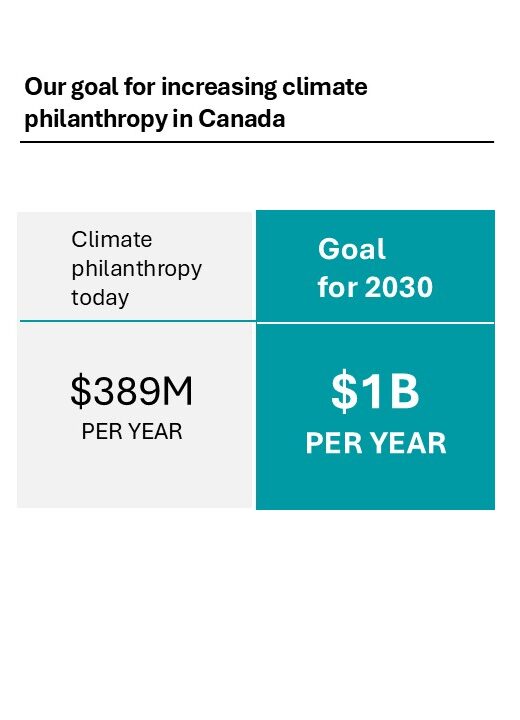
Aiming for $1 billion by 2030.
With climate philanthropy in Canada lagging, we simply must facilitate more of it.
Our first goal should be to match the global average as soon as possible. That means lifting climate philanthropy in Canada from 1.5 percent of total philanthropic giving to 1.8 percent, which in turn means growing climate philanthropy from 2023’s $389 million to at least $467 million.
But we need to quickly set our sights higher than this. Canada’s contribution to climate pollution is among the highest in the world. And while it is industry and governments that ultimately need to do the heavy lifting to move Canada to net-zero emissions, philanthropy can be the all-important first domino that sets the rest of the chain in motion. So the moment for climate philanthropy is now.
For that reason, Clean Economy Fund’s objective it to grow climate philanthropy in Canada to $1 billion per year by 2030, almost triple what we see in 2023. That may seem a tall order but it is necessary given the scale of the climate crisis we face. Tripling the amount of climate philanthropy could, in effect, triple the amount of innovation, triple the amount of advocacy and mobilization, and triple the size of the giant leaps we take.
At Clean Economy Fund, we believe this goal becomes achievable when the philanthropic community, and Canadians writ large, see the impact that every philanthropic dollar can have when it’s well targeted. And that is the value we can provide.
In the words of one of Canada’s hockey greats, “you miss 100 percent of the shots you don’t take”. When it comes to climate solutions, it’s time for Canada’s philanthropic community to take a big shot at $1 billion by 2030. Clean Economy Fund is excited to support our peers to shoot, and to score, with this ambitious goal.
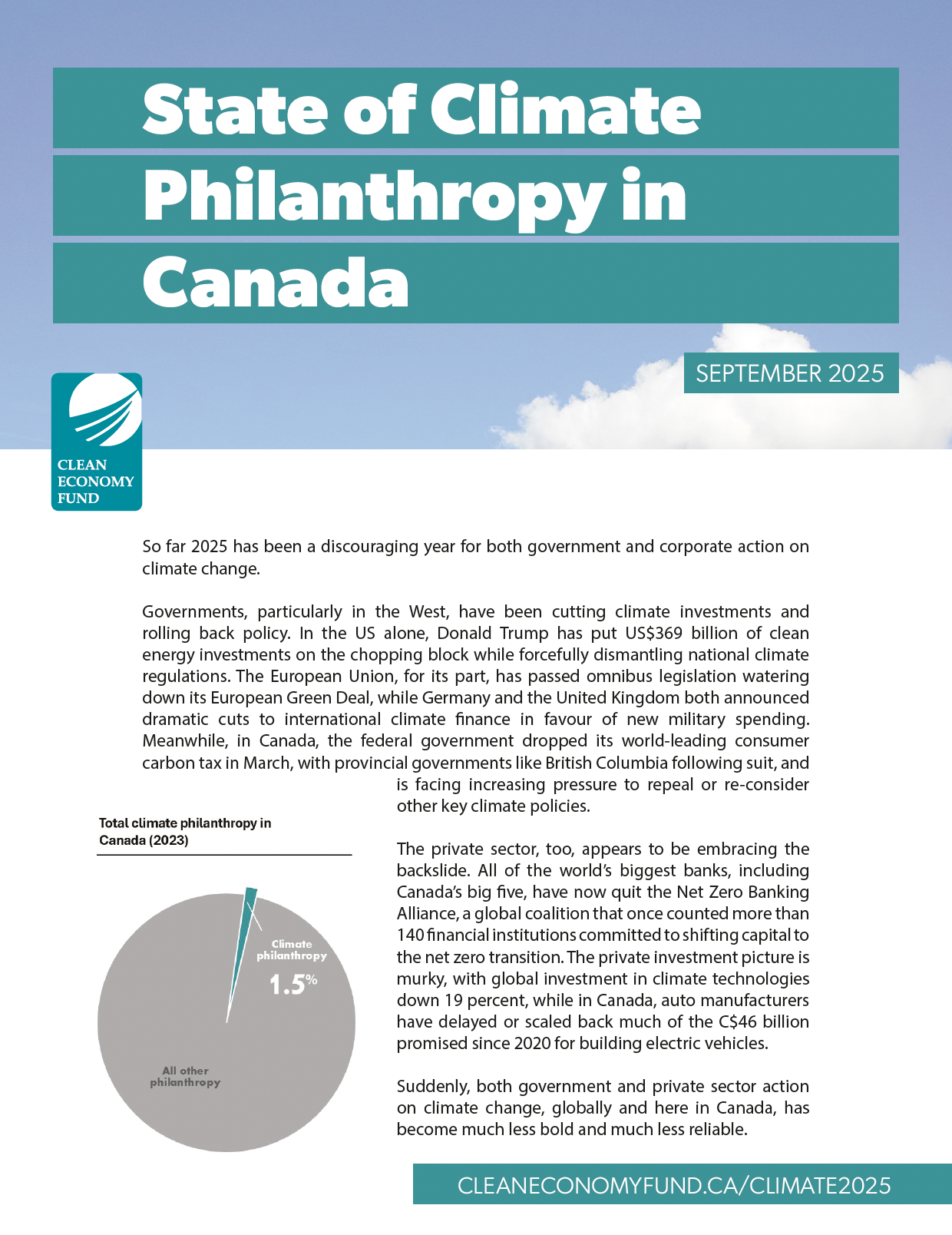
Download the report [PDF]
A note on our methodology
Note: Last year, Clean Economy Fund piloted a first-ever calculation of total climate philanthropy in Canada, using 2022 data. As is so often the case, the first attempt was imperfect. The methodology used in this year’s calculation includes a number of modifications that, in our view, improve the credibility of the calculation. Because of these modifications, we caution against comparing the two analyses. Going forward, we intend to use this calculation for 2023 as our baseline year.
What is climate philanthropy?
Climate philanthropy, also referred to sometimes as “climate-focused philanthropy” or “climate change mitigation philanthropy”, is charitable giving that is targeted at reducing, removing and avoiding the greenhouse gas pollution that causes climate change.
This definition allows for a broad range of charitable giving, but importantly, does not include nature conservation, species protection and climate adaptation, which we consider all related but separate philanthropic causes.
Clean Economy Fund’s “State of Climate Philanthropy” report depends on three valuable sources for further defining climate philanthropy.
First is Canada’s Official Greenhouse Gas Inventory, which is mandated and standardized for all signatories to the UN Framework Convention on Climate Change for reporting GHG emissions and removals. The Inventory provides a detailed breakdown of where GHG pollution is originating in Canada, offering a clear reference for the parameters of climate-focused philanthropy. The Inventory is built around five key sources: (1) Energy, (2) Industrial Processes and Product Use, (3) Agriculture, (4) Land Use, Land Use Change and Forestry, and (5) Waste.
A second valuable source is the US-based ClimateWorks Foundation, which has developed a sophisticated methodology for defining and measuring climate philanthropy, which it applies in its annual Funding Trends report. ClimateWorks defines climate philanthropy within the context of 15 sectors and strategies: (1) Buildings, (2) Carbon Dioxide Removal, (3) Challenge Fossil [Fuels], (4) Cities, (5) Clean Electricity, (6) Cooling, (7) Core and Capacity Building, (8) Food & Agriculture, (9) Forests, (10) Governance, Diplomacy & Legal, (11) Industry, (12) Public Engagement, (13) Super Pollutants, (13) Sustainable Finance, (14) Transportation, and (15) Other Climate Change Mitigation Strategies. See ClimateWorks’ latest Funding Trends report for explanations of how each of these sectors and strategies gets treated in their definition.
The third and final valuable source for defining climate philanthropy is Environment Funders Canada’s regular Environmental Grants Data report, in which it defines climate change as one of a number of categories of grant-making. To determine which grants fall into the climate category, EFC tracks for 11 keywords: (1) Climate, (2) Energy, Wind, Solar, Geothermal, Hydropower & Tidal, (3) Building, (4) Policy, (5) Carbon, (6) Greenhouse gas, GHGs, (7) Emissions, (8) Electric, (9) Oil, (10) Coal, and (11) Net-zero. Importantly, Environment Funders Canada also discounts certain keywords, which include Conservation and Water Quality.
Ultimately, because the “State of Climate Philanthropy” report depends on a degree of self-reporting by philanthropic foundations, we must allow for different interpretations and some variance in the definition of climate philanthropy and in the foundation-led philanthropy that factors into our calculation.
Arriving at our calculation
Determining total climate philanthropy in Canada is a tricky undertaking. The data needed for a comprehensive accounting is lacking. Instead, our analysis draws on a few resources that, while having limitations, are rigorous and dependable.
We calculated total philanthropy in Canada using the revenues reported by Canadian charitable organizations to the Canada Revenue Agency on the annual Registered Charity Information Return (T3010). We depended especially on the excellent treatment of this data provided by Blumbergs on its CanadianCharityLaw.ca website. Specifically, our figure for total philanthropy is the total of the revenues reported by charitable organizations from (1) tax-receiptable donations (Line 4500), (2) transfers from other charities (Line 4510), and (3) non-receipted gifts (Line 4530). For reasons well explained by others, including Imagine Canada, this is a more dependable indication of total philanthropy than the donations claimed annually by Canadian taxpayers on their T4 forms.
We calculated total climate philanthropy in Canada through a two-step process.
The first step was calculating foundation-led philanthropy. That involved a three-pronged approach of (1) consulting Environment Funders Canada’s invaluable Environmental Grants Data report for 2023, which reports on the climate grants made by 68 of its members, (2) adding the philanthropic contributions from a handful of foundations not included in the EFC report, which were collected directly by Clean Economy Fund as well as from Blumbergs’ charitydata.ca resource, and (3) adding a 5 percent cushion to allow for foundation-led philanthropy that is unknown to us.
The second step was calculating individual and corporate donations. Unfortunately, data is not collected in Canada for the specific sector destinations of individual and corporate donations, and so this calculation must be an estimate. The estimate is arrived at by applying to the climate sector the same ratio of individual-to-foundation philanthropy that is observed in the charity sector writ large. That ratio, derived from Blumbergs’ analysis of 2023 T3010 returns, is 1.96:1. In other words, individual and corporate donations were 196 percent of foundation-led philanthropy in 2023. We assume the same for climate philanthropy, specifically.
Combining the total of these two steps gives us the figure for total climate philanthropy in Canada in 2023. Measuring that figure against our figure for total philanthropy more broadly in Canada in 2023 gives us the proportion of total philanthropic giving that goes toward climate solutions.
